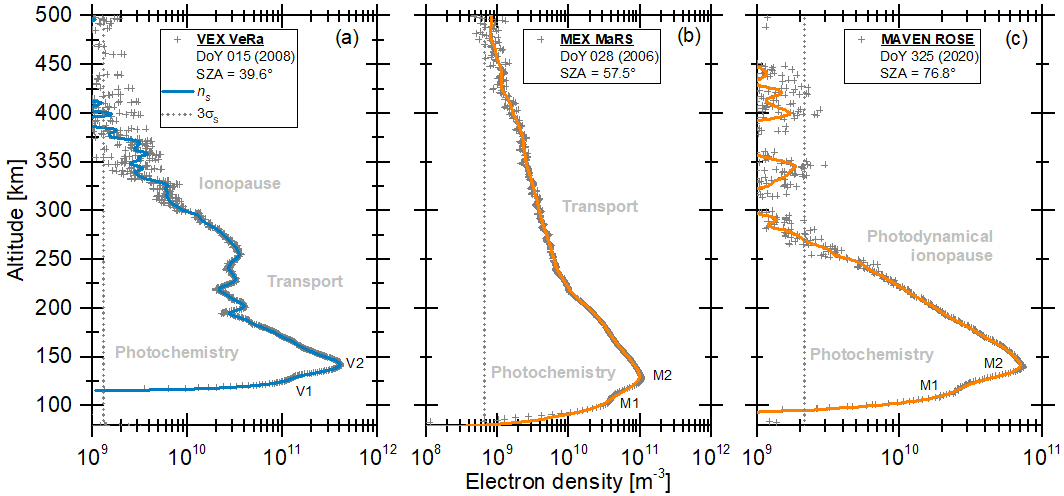- 1Rheinisches Institut für Umweltforschung an der Universität Köln, Planetary Research, Germany (peterk@uni-koeln.de)
- 2Department of Astronomy, Boston University, Boston, MA, USA
- 3Laboratory for Atmospheric and Space Physics, University of Colorado, Boulder, USA
- 4Max Planck Institut für Sonnensystemforschung, Göttingen, Germany
- 5Universität der Bundeswehr München, Neubiberg, Germany
- 6Swedish Institute of Space Physics, Kiruna, Sweden

Fig. 1: Topside ionospheres of Venus and Mars as seen by (a) VEX VeRa, (b) MEX MaRS and (c) MAVEN ROSE.radio science.
While the orbital and environmental parameters of Venus and Mars show significant differences, their planetary ionospheres show notable similarities (Figure 1). The photochemically dominated regions of the undisturbed dayside ionospheres of Venus and Mars are both characterized by two major features. The ionospheric main peak region (V2 at Venus, M2 at Mars) is a result from photoionization by solar EUV irradiation. The weaker secondary V1/M1 region originates from the primary and secondary ionization of the neutral atmosphere caused by solar X-ray radiation. The upper region of the Venus and Mars dayside ionospheres is governed by transport processes.
The extent and shape of the ionospheric topsides is observed with the radio science experiments Venus Express Radio Science (VeRa) onboard Venus Express (VEX) [1] at Venus and Mars Express Radio Science (MaRS) [2] onboard Mars Express (MEX) and the Radio Occultation Science Experiment (ROSE) onboard the MAVEN spacecraft [3] at Mars. The observed electron density exhibits substantial variability on temporal scales and ranges from an undisturbed exponential decay (Fig. 1b) to strongly compressed shapes (Fig. 1a, c).
This work combines 9 years of VEX-VeRa (2006-2014), 18 years of MEX-MaRS (2004-2021) and 8 years of MAVEN-ROSE (2014-2021) radio occultation observations to investigate the variability of the topside ionospheres of Venus and Mars on the planetary dayside. The derived ionospheric characteristics will be compared to accompanying observations of the solar wind dynamic pressure (from VEX-ASPERA4 [4], MEX-ASPERA3 [5, 6] and MAVEN instruments [7]), solar irradiation flux (FISM-V2 model [8], MAVEN EUV monitor [9]) and a model of the crustal magnetic field for Mars [10] to improve our understanding of the solar wind interaction of planets without a global magnetic field.
References
[1] Häusler et al. (2006) PSS 54 (13-14)
[2] Pätzold et al. (2004) in Fletcher (2004) Mars Express. The scientific payload. ESA
[3] Withers et al. (2018) JGR Space Phys. 123 (5)
[4] Barabash et al. (2007) PSS 55 (12)
[5] Barabash et al. (2006) SSR 126
[6] Ramstad et al. (2015) JGR Planets 120 (7)
[7] Halekas et al. (2015) SSR 195
[8] Chamberlin et al. (2020) Space Weather 18 (12)
[9] Thiemann et al. (2017) JGR Space Physics 122 (3)
[10] Morschhauser et al. (2014) JGR Planets 119 (6)
How to cite: Peter, K., Pätzold, M., Withers, P., Ramstad, R., Thiemann, E., Fränz, M., Häusler, B., Futaana, Y., and Holmström, M.: Dynamics of the topside ionospheres of Venus and Mars as seen by recent radio science observations, Europlanet Science Congress 2024, Berlin, Germany, 8–13 Sep 2024, EPSC2024-481, https://doi.org/10.5194/epsc2024-481, 2024.